The rather strange summer weather continued in August when it could best be described as variable. We lost a few flying days to wet weather but at other times it was perfect.
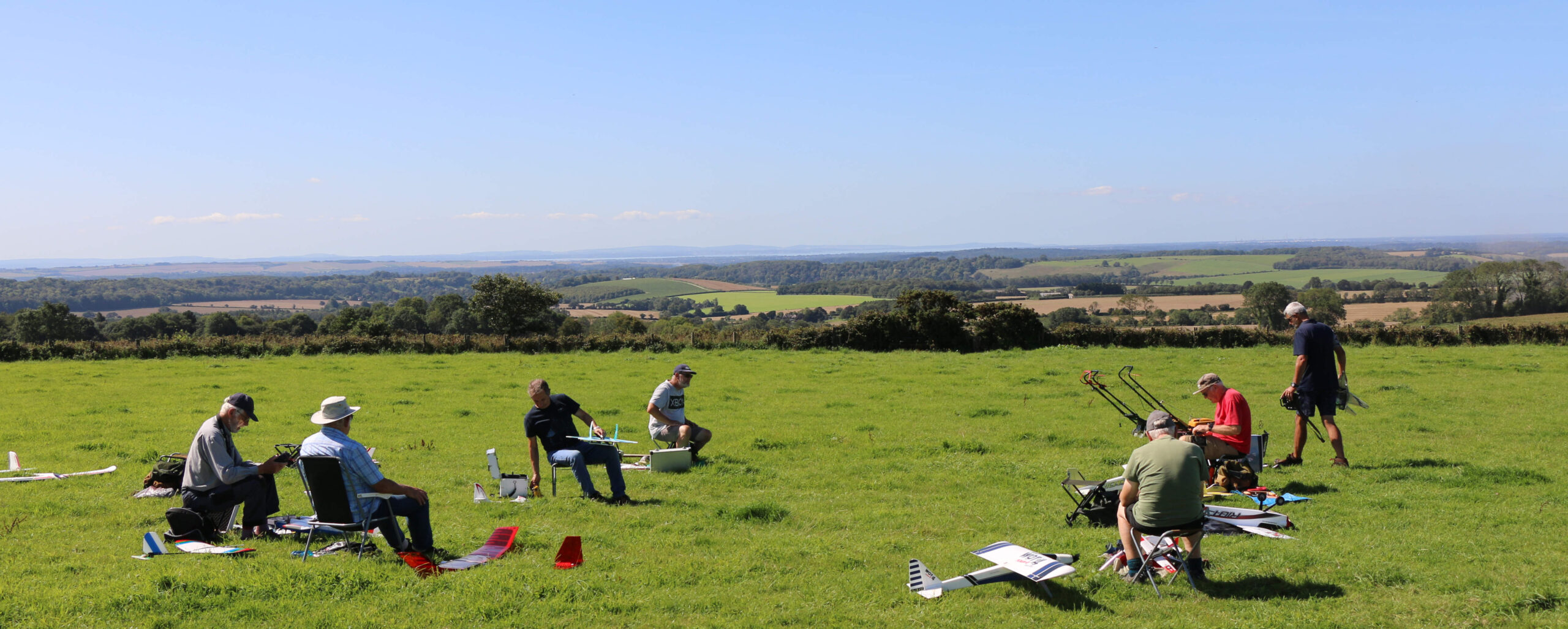 The mixture of rain and sunshine meant the patch grass grew a lot and several mowing sessions were required, we even mowed twice one week There were some bullocks in the field for some of the month but they paid little attention to us and were rarely any bother.
The mixture of rain and sunshine meant the patch grass grew a lot and several mowing sessions were required, we even mowed twice one week There were some bullocks in the field for some of the month but they paid little attention to us and were rarely any bother.
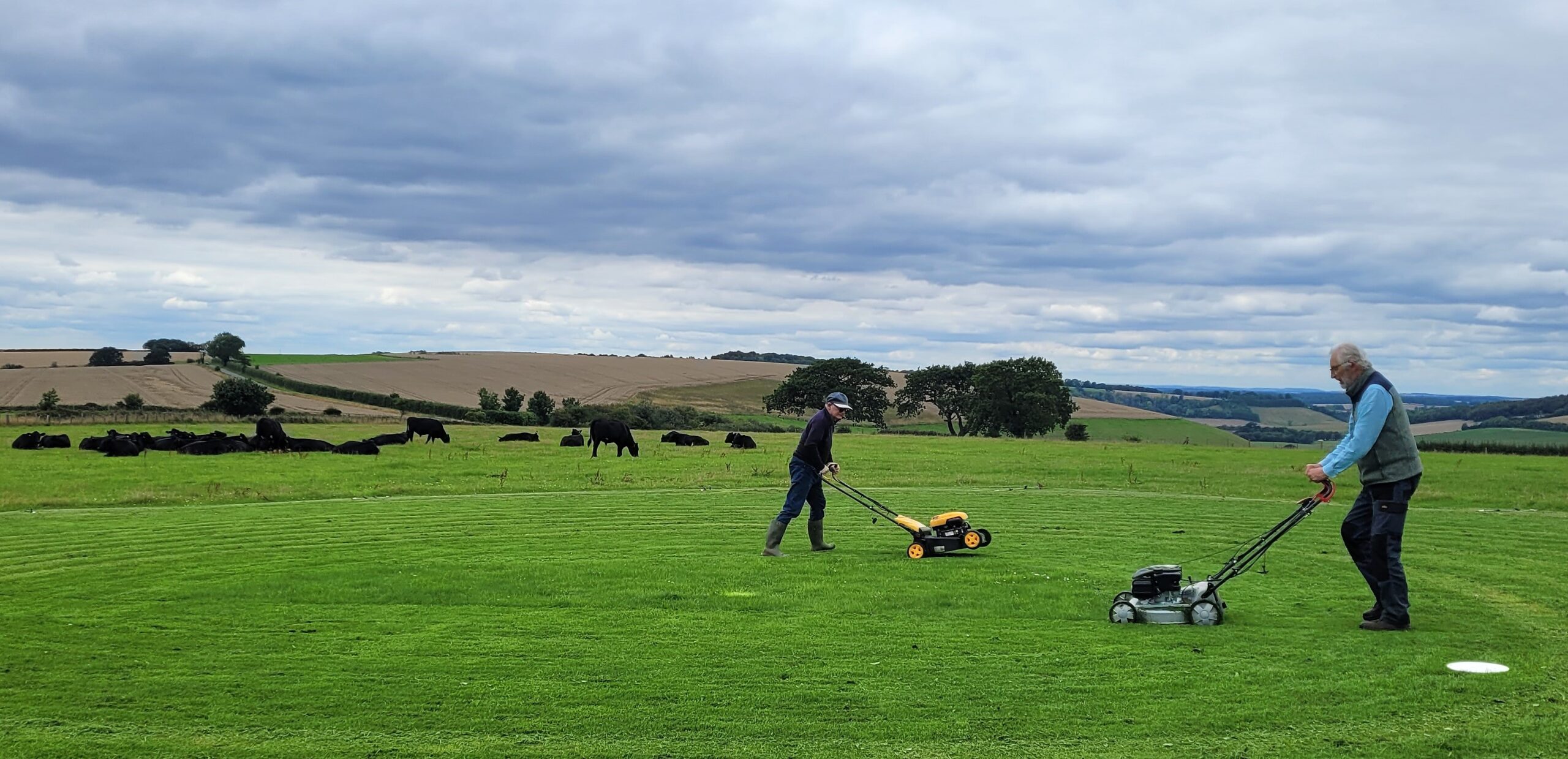 I rather like this photo of bullocks, Bob the Builder, and Dwayne Pipe. Perhaps we should explain to Dwayne that the mower cuts better when all four wheels are on the ground!
I rather like this photo of bullocks, Bob the Builder, and Dwayne Pipe. Perhaps we should explain to Dwayne that the mower cuts better when all four wheels are on the ground!
The bullocks seem to enjoy standing on the box and the lid was rather battered and was leaking so Chairman Gordon Bennett and 1066 strengthened it with a layer of chequer plate. At the same time Woody and I replaced the electric fence wire which was starting to deteriorate. Gordon and Woody also did some mower running repairs and servicing but later we found that the older mower refused to run at anything above idling speed.
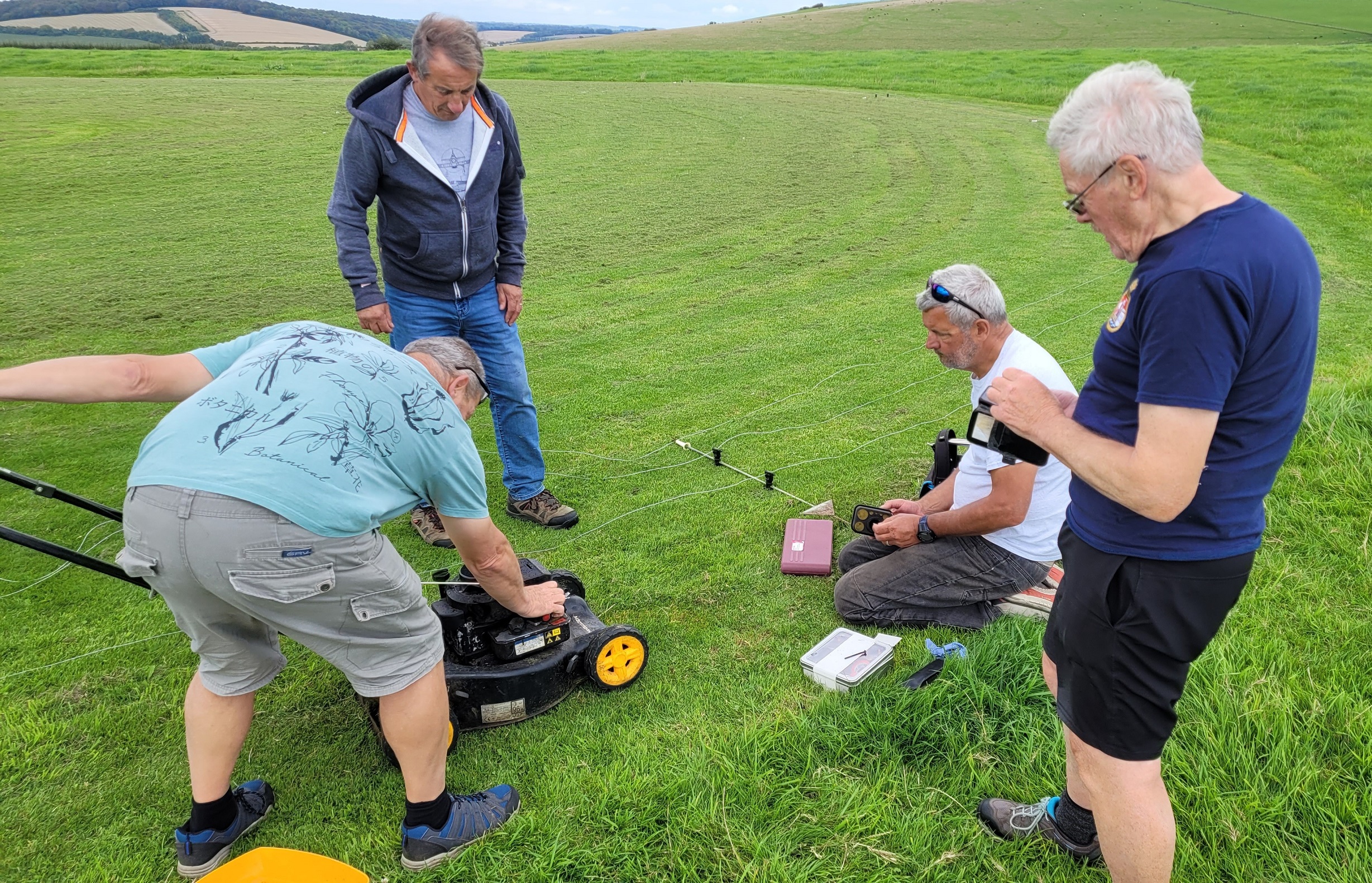 Several of us failed to fix it but Chas volunteered to take a look and he’s now got it sorted.
Several of us failed to fix it but Chas volunteered to take a look and he’s now got it sorted.
Quite a few new models were flown in August, the first being the Wasp E2K belonging to Page Boy who has recently returned to the club. The Wasp is primarily designed as an electric powered pylon racer to compete in the E2K class but it also makes a good sport model, 1066 has been flying one regularly for quite a while now. It’s available in kit form and has a built up fuselage and veneered foam wing of 900mm span. This Wasp is actually Page Boy’s second one, the first one had the wing rip off which terminated the flight suddenly and permanently! But it had already had a good few flights so Page Boy wasn’t too upset and decided he’d enjoyed it enough to put another one together.
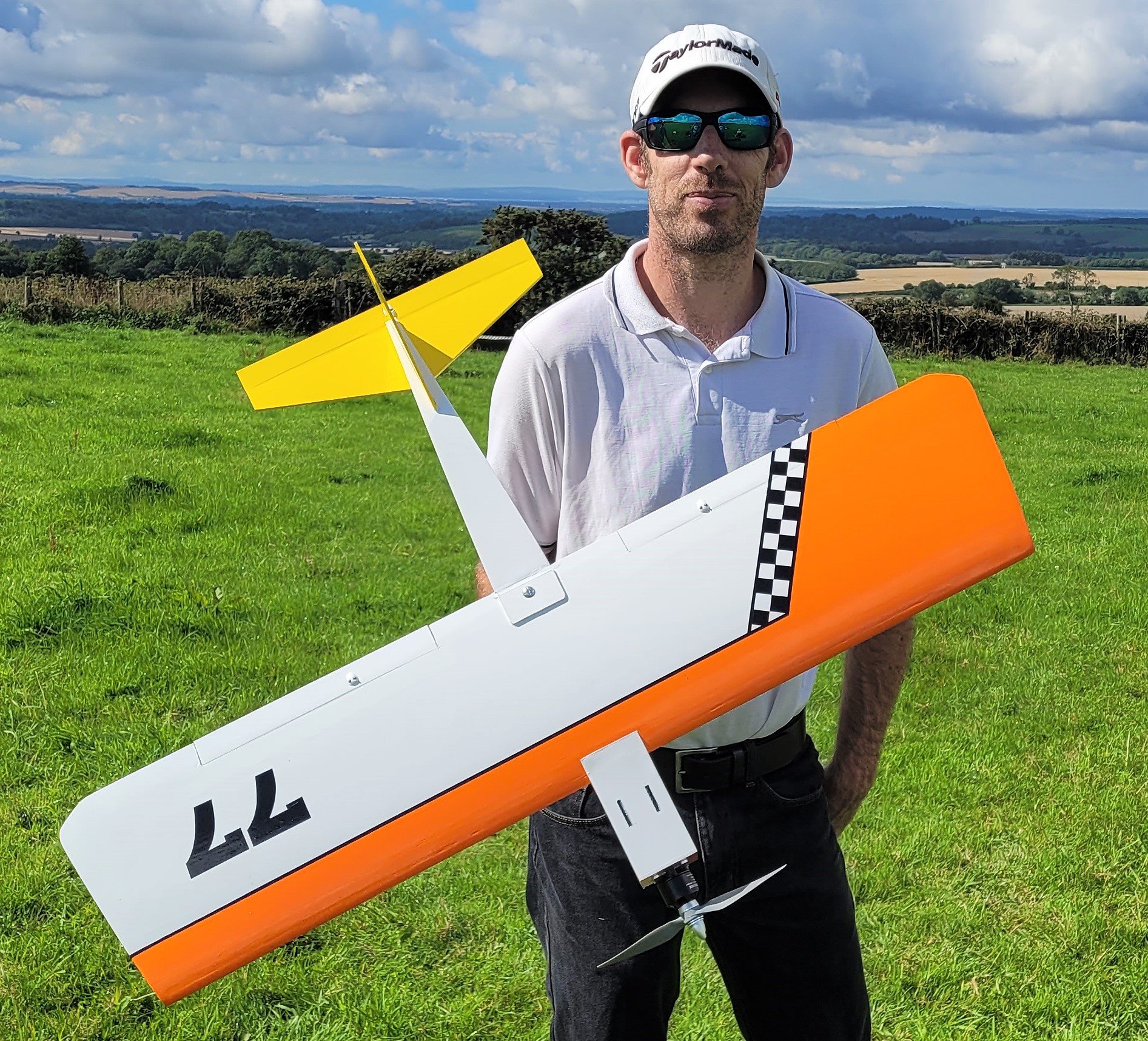 The motor is a 1500kv Tornado Thumper 3536 which swings an 8×6 APC prop. He’s fitted an 80A Hobbywing speed controller and uses 2600mAh 50C 4 cell lipos to power it all. The Wasp only uses three servos, the two aileron ones are Hitec HS65MGs (metal gears) and the elevator servo is a Hitec HS85MG, these are small and light but powerful enough to take the loads achieved in pylon racing. Page Boy used HobbyKing covering film and the completed model weighs in at 2.4lbs. So how does it go? Very quickly! To me it looked a bit faster than 1066’s but maybe that’s just because I’ve got used to 1066’s having seen it fly lots of times. So what we need now is for both of them to be flown together so we can compare. Come on chaps, get it together and have a proper race, you know you want to!
The motor is a 1500kv Tornado Thumper 3536 which swings an 8×6 APC prop. He’s fitted an 80A Hobbywing speed controller and uses 2600mAh 50C 4 cell lipos to power it all. The Wasp only uses three servos, the two aileron ones are Hitec HS65MGs (metal gears) and the elevator servo is a Hitec HS85MG, these are small and light but powerful enough to take the loads achieved in pylon racing. Page Boy used HobbyKing covering film and the completed model weighs in at 2.4lbs. So how does it go? Very quickly! To me it looked a bit faster than 1066’s but maybe that’s just because I’ve got used to 1066’s having seen it fly lots of times. So what we need now is for both of them to be flown together so we can compare. Come on chaps, get it together and have a proper race, you know you want to!
Next up is another foamboard special from Dwayne Pipe who has written all about it:
F35 foam board- what could possibly go wrong? One of the joys of model aircraft modelling for me is making a new model. I know you can go and buy a ready to fly model and get it to work first time (If you are lucky) but making a new model from scratch and flying it beats the out of the box item every time. Having demolished my Sea Vixen, I fancied a different challenge. A model no one else had in the club.
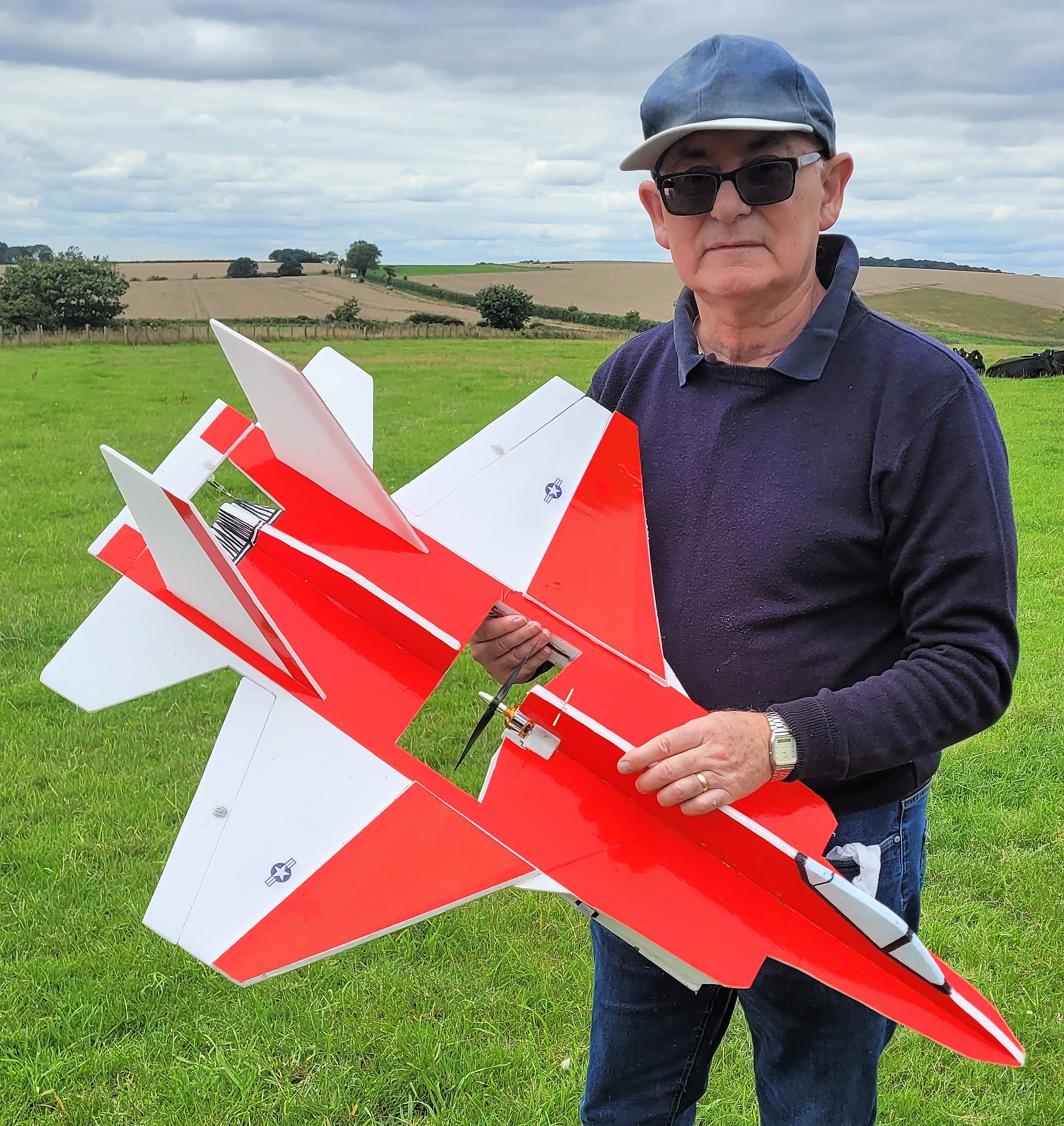 I chose the F35 multipurpose fighter because I had seen a pair doing a low pass over the Lake District while on holiday last year and they looked great in the air. The design was a variation on the foam board fighters we have been flying for some time, but I thought I would make it in Correx as it was stronger than the foam board we normally use and because I had a couple of sheets spare. I drew out the plans, cut the board and glued it together with hot melt. (Hot melt sticks really well to Correx). It was covered in Fablon (remember that stuff from the 1960s). With it ready to fly Andy launched it into space.
I chose the F35 multipurpose fighter because I had seen a pair doing a low pass over the Lake District while on holiday last year and they looked great in the air. The design was a variation on the foam board fighters we have been flying for some time, but I thought I would make it in Correx as it was stronger than the foam board we normally use and because I had a couple of sheets spare. I drew out the plans, cut the board and glued it together with hot melt. (Hot melt sticks really well to Correx). It was covered in Fablon (remember that stuff from the 1960s). With it ready to fly Andy launched it into space. 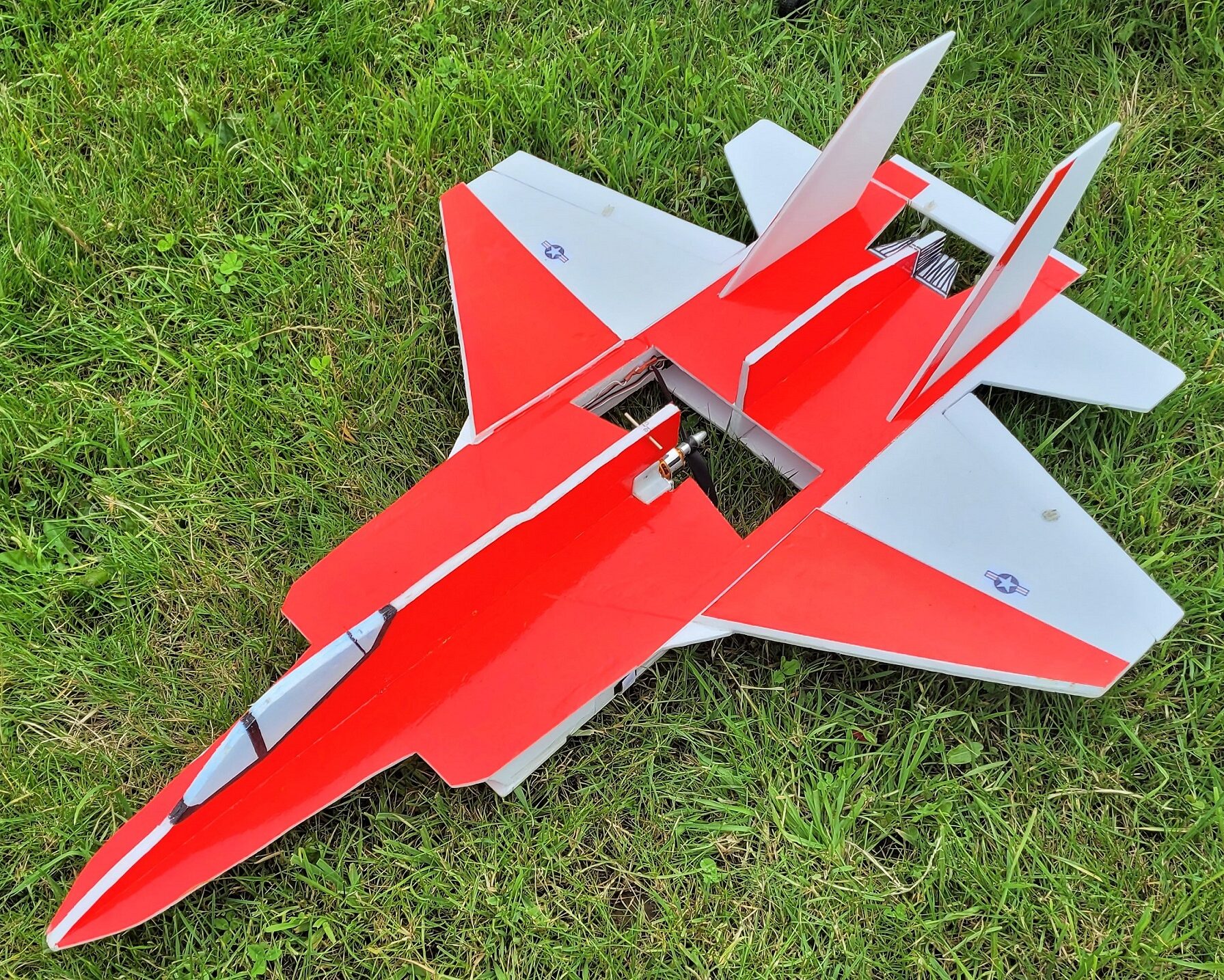 The result was disastrous. The plane was overweight, underpowered, the C of G was miles too far back and the servo on the elevator refused to work while flying but was great on the ground. A few more attempts tinkering around with the motor, propeller, and C of G, all I succeeded in doing was destroying the airframe.
The result was disastrous. The plane was overweight, underpowered, the C of G was miles too far back and the servo on the elevator refused to work while flying but was great on the ground. A few more attempts tinkering around with the motor, propeller, and C of G, all I succeeded in doing was destroying the airframe.
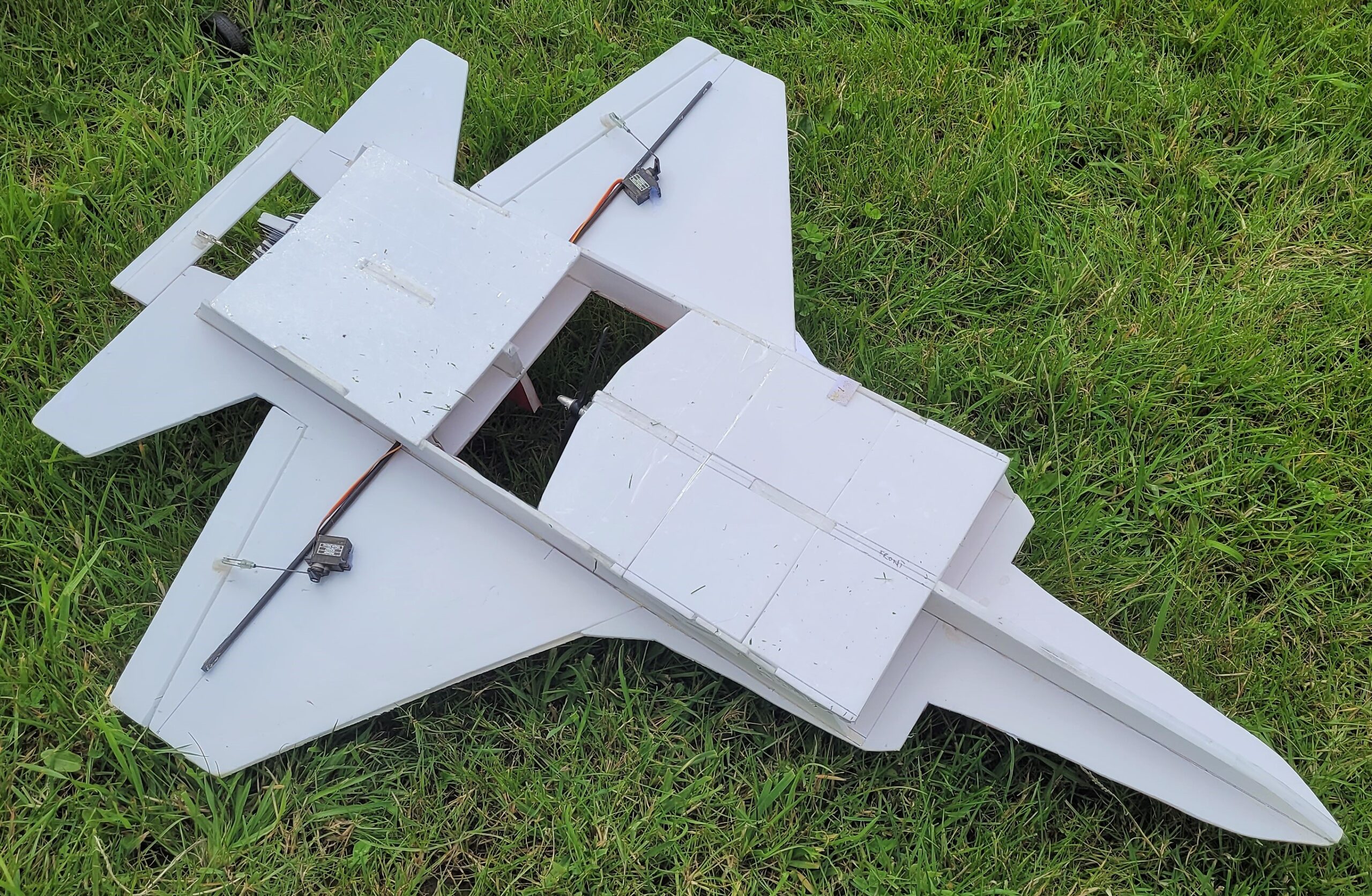 As they say “back to the drawing board”. I had already made the plans so this time I went back to good old Hobbycraft foam board. The model was kitted out the same, although I bought three new servos this time. Andy launched it again and surprise, surprise, the model was way too tail heavy. The old saying is “if you keep on doing what you’re doing you will keep on getting what you’re getting”.
As they say “back to the drawing board”. I had already made the plans so this time I went back to good old Hobbycraft foam board. The model was kitted out the same, although I bought three new servos this time. Andy launched it again and surprise, surprise, the model was way too tail heavy. The old saying is “if you keep on doing what you’re doing you will keep on getting what you’re getting”.
I use an online computer program “Aircraft centre of gravity calculator” from RC Planes online. Over the years it has worked really well with all my home-built models. The foam board models don’t have an airfoil and as the wings are flat the angle of attack provides the lift. The program uses the wing and tail area to calculate the C of G. The F35 is a unique shape as the wing and tail virtually morph together and there is a large amount of lift generated by the front of the plane forward of the wing, which is unusual. 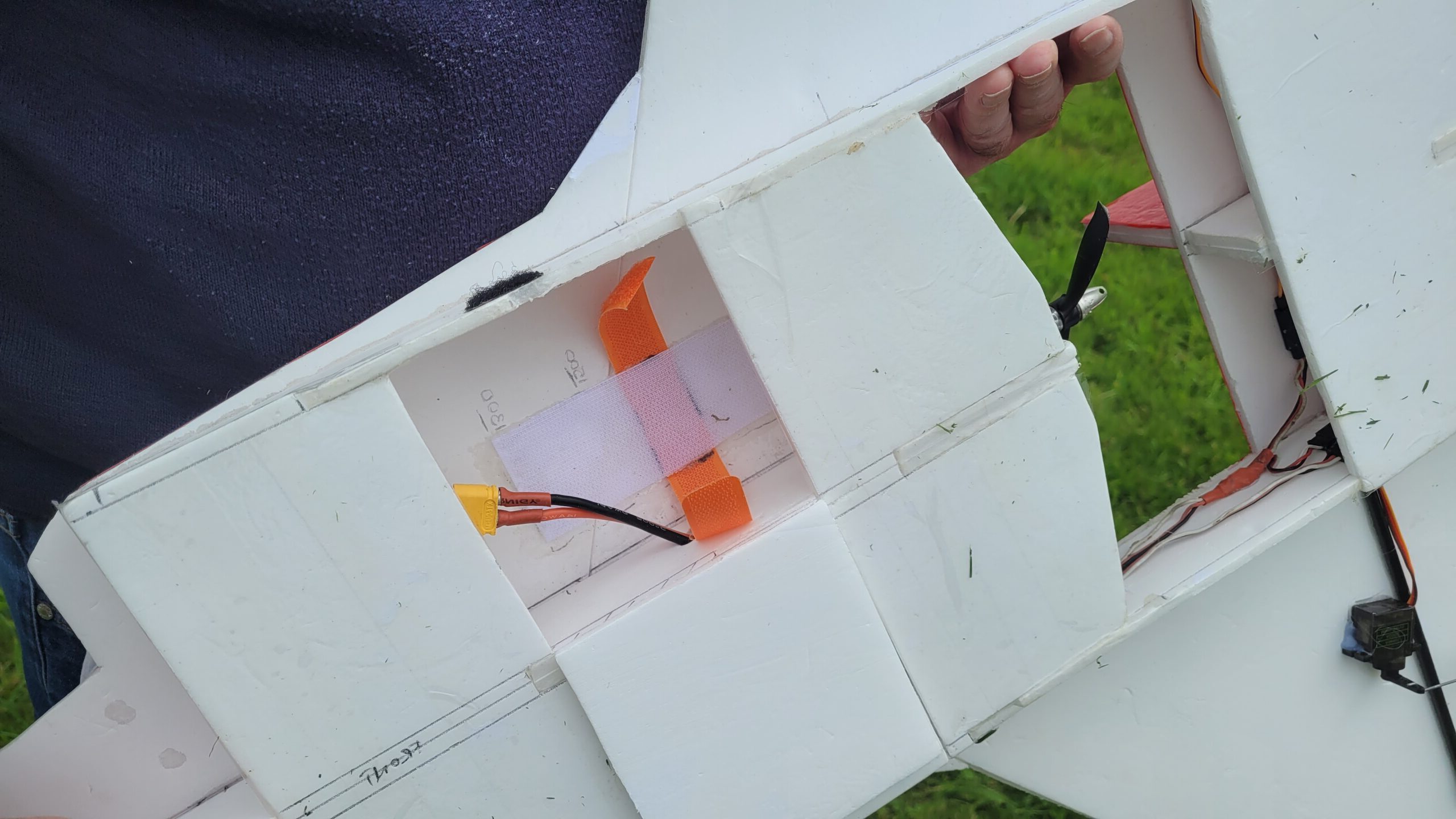 Adding the area in front of the wing into the program shifted the C of G forward over 2 inches. I moved the battery position to achieve this. This time she flew beautifully, the only problem now is the pilot. The hassle is part of the process but there is a real buzz when it works out at last. For those who like the technical stuff, the model has a wingspan of 30 inches, a 2200 Kv motor pulling a 6×4 prop and a 25 A Esc. The Correx version had a flying weight of 800 grams, the foam board a flying weight of 550 grams. Thanks for the excellent report Dwayne. It looks great in the air as you can see in this month’s video.
Adding the area in front of the wing into the program shifted the C of G forward over 2 inches. I moved the battery position to achieve this. This time she flew beautifully, the only problem now is the pilot. The hassle is part of the process but there is a real buzz when it works out at last. For those who like the technical stuff, the model has a wingspan of 30 inches, a 2200 Kv motor pulling a 6×4 prop and a 25 A Esc. The Correx version had a flying weight of 800 grams, the foam board a flying weight of 550 grams. Thanks for the excellent report Dwayne. It looks great in the air as you can see in this month’s video.
I finally got around to putting together one of the four foamboard models that I’ve bought and then ignored for months. I bought it back in January when I was browsing the AliExpess website and spotted it for just £11.12 plus £2.23 VAT, too cheap to ignore!
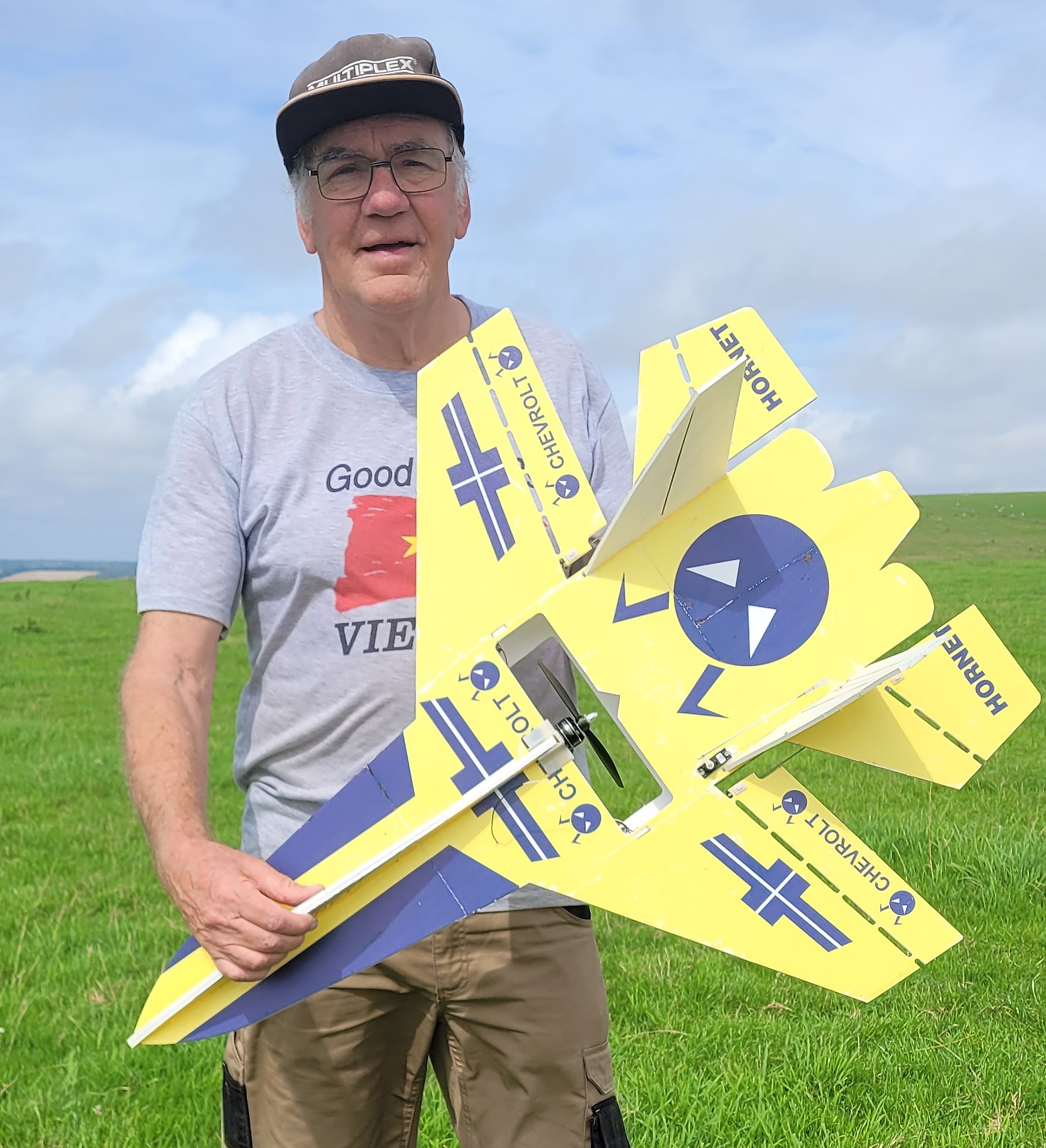 How bad could it be for that price? The kit only contains the foam parts, no carbon stiffening rods, no control linkages, and no instructions. I was rather surprised when it turned up in jiffy bag with no protection at all but all the parts had survived the trip from China without being damaged. It’s available in several colour schemes and is sold as an SU-27 but the yellow and black one that I chose says Hornet on it, presumably named after the insect rather than the F-18 Hornet as it also has what I guess are Hornet head outlines.
How bad could it be for that price? The kit only contains the foam parts, no carbon stiffening rods, no control linkages, and no instructions. I was rather surprised when it turned up in jiffy bag with no protection at all but all the parts had survived the trip from China without being damaged. It’s available in several colour schemes and is sold as an SU-27 but the yellow and black one that I chose says Hornet on it, presumably named after the insect rather than the F-18 Hornet as it also has what I guess are Hornet head outlines.
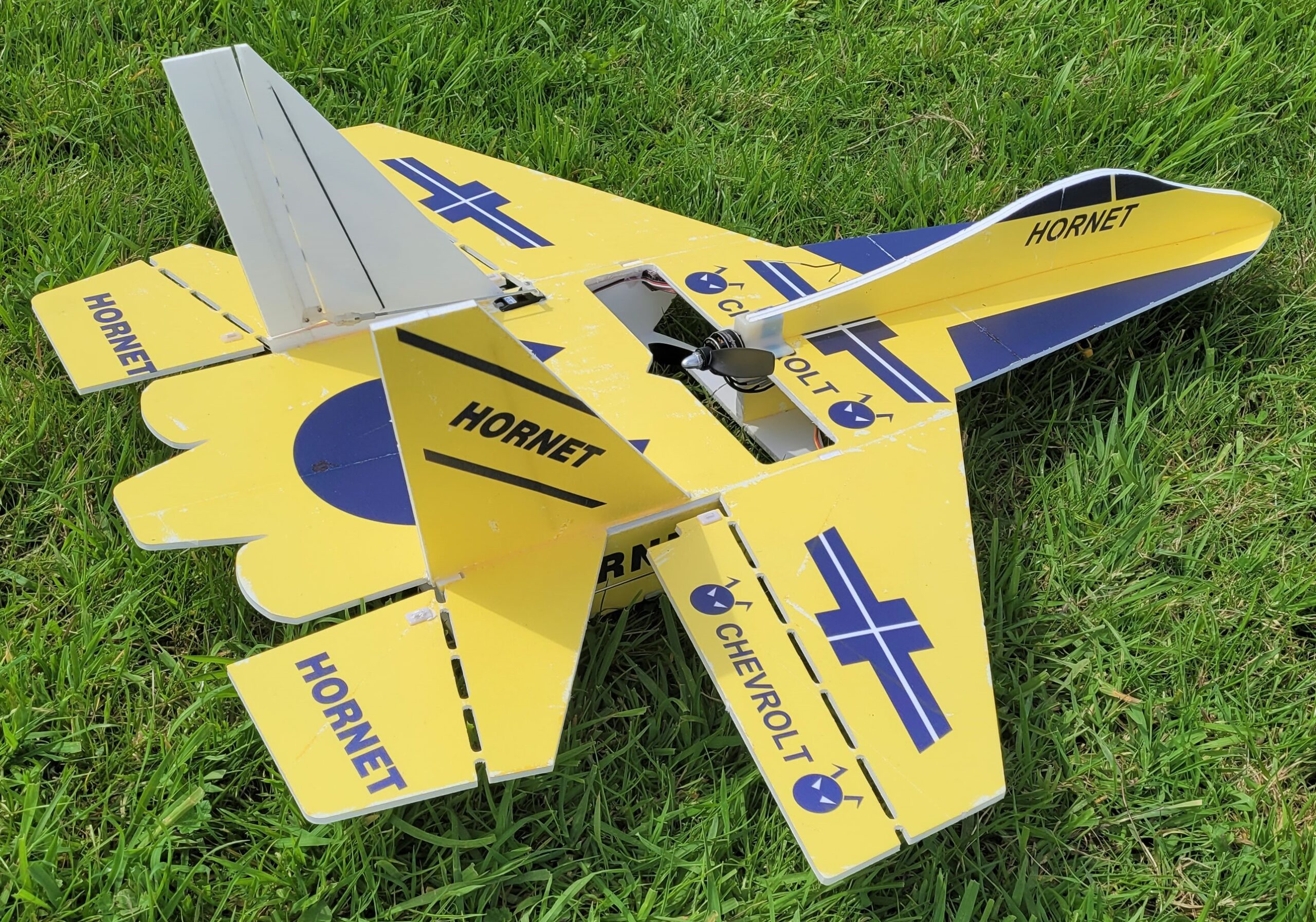 It also says Chevrolt (not Chevrolet) so it’s all rather confusing. The outline shape probably matches an SU-27 slightly more closely than an F-18 but I decided that mine was going to be an F-18 so I angled both fins out slightly. It went together easily using both hot-melt glue and cyano and I used some carbon rods for spars that I’d salvaged from the wreck of my SU-27 and I also added some carbon strips to the fins after I had glued them in place as they seemed a bit floppy. I added a rudder as all the foamboards seem to need one for high alpha manoeuvres. I fitted a 2306-2200kv motor and a very cheap 30A speed controller which lasted three flights before it burnt out and was replaced by a better one.
It also says Chevrolt (not Chevrolet) so it’s all rather confusing. The outline shape probably matches an SU-27 slightly more closely than an F-18 but I decided that mine was going to be an F-18 so I angled both fins out slightly. It went together easily using both hot-melt glue and cyano and I used some carbon rods for spars that I’d salvaged from the wreck of my SU-27 and I also added some carbon strips to the fins after I had glued them in place as they seemed a bit floppy. I added a rudder as all the foamboards seem to need one for high alpha manoeuvres. I fitted a 2306-2200kv motor and a very cheap 30A speed controller which lasted three flights before it burnt out and was replaced by a better one.
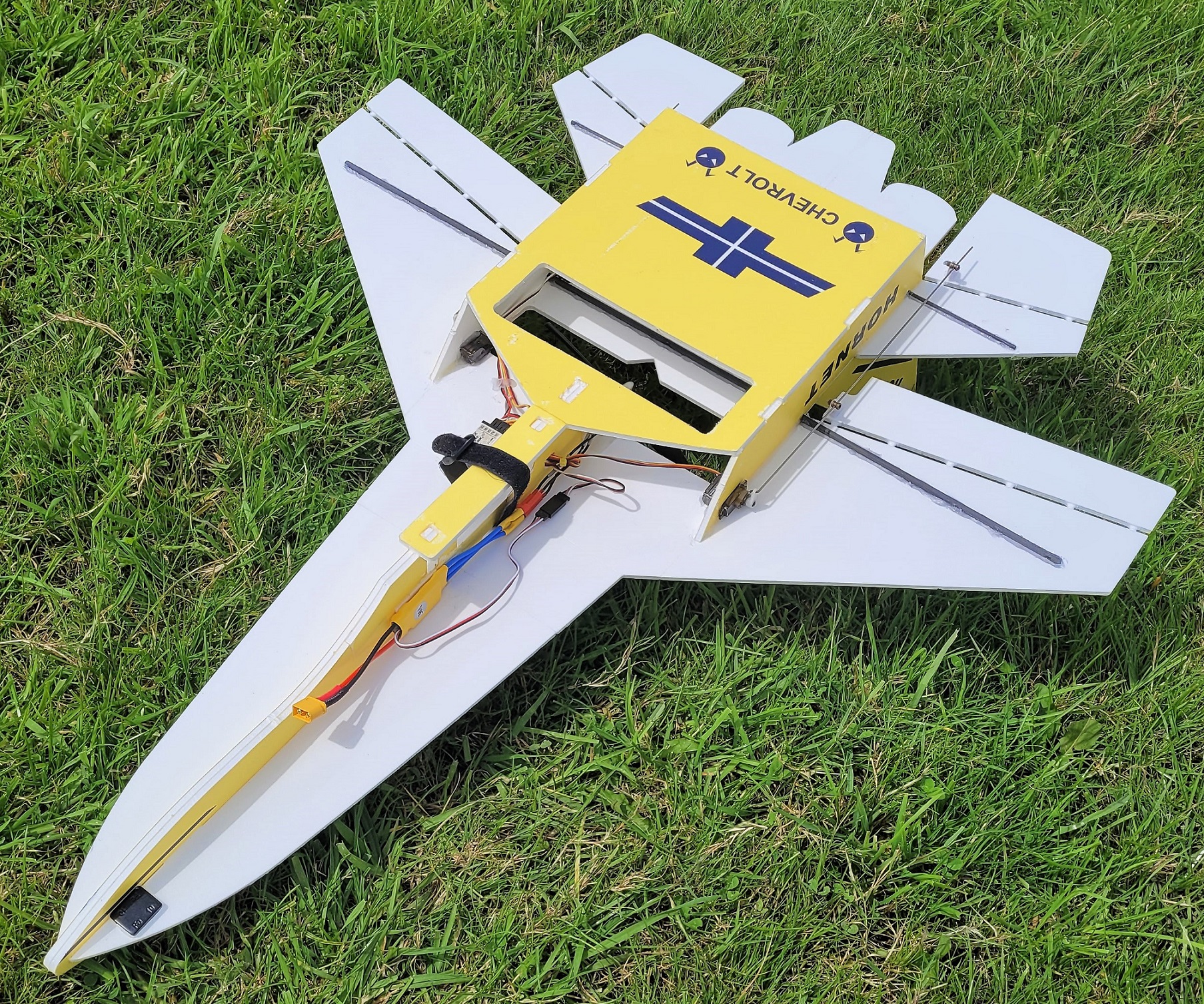 I wasn’t sure where the centre of gravity should be so I made a guesstimate and added a little nose-weight. For the first flight I fitted a three cell 1400mAh lipo and it flew perfectly, barely needing any trim at all and it handled very nicely. I have since opened up the slot where the battery fits so I can also use 2200mAh packs and I’ve also removed the nose-weight and glued it to the tail instead. It is still available on the AliExpress website but at the time of writing the price has risen to £23.86 with free postage but it will add 20% VAT to the total making it £28.63. I’m very happy with the Hornet, it really is much nicer to fly than my Yak-130. You can see some of the first flight in the video.
I wasn’t sure where the centre of gravity should be so I made a guesstimate and added a little nose-weight. For the first flight I fitted a three cell 1400mAh lipo and it flew perfectly, barely needing any trim at all and it handled very nicely. I have since opened up the slot where the battery fits so I can also use 2200mAh packs and I’ve also removed the nose-weight and glued it to the tail instead. It is still available on the AliExpress website but at the time of writing the price has risen to £23.86 with free postage but it will add 20% VAT to the total making it £28.63. I’m very happy with the Hornet, it really is much nicer to fly than my Yak-130. You can see some of the first flight in the video.
Peter F has been a member for a while now and his flying has come on in leaps and bounds since passing his ‘A’ cert back in December. He’s definitely earned himself a Patch News pseudonym so from now on Peter is MacFly, the Mac being taken from his middle name.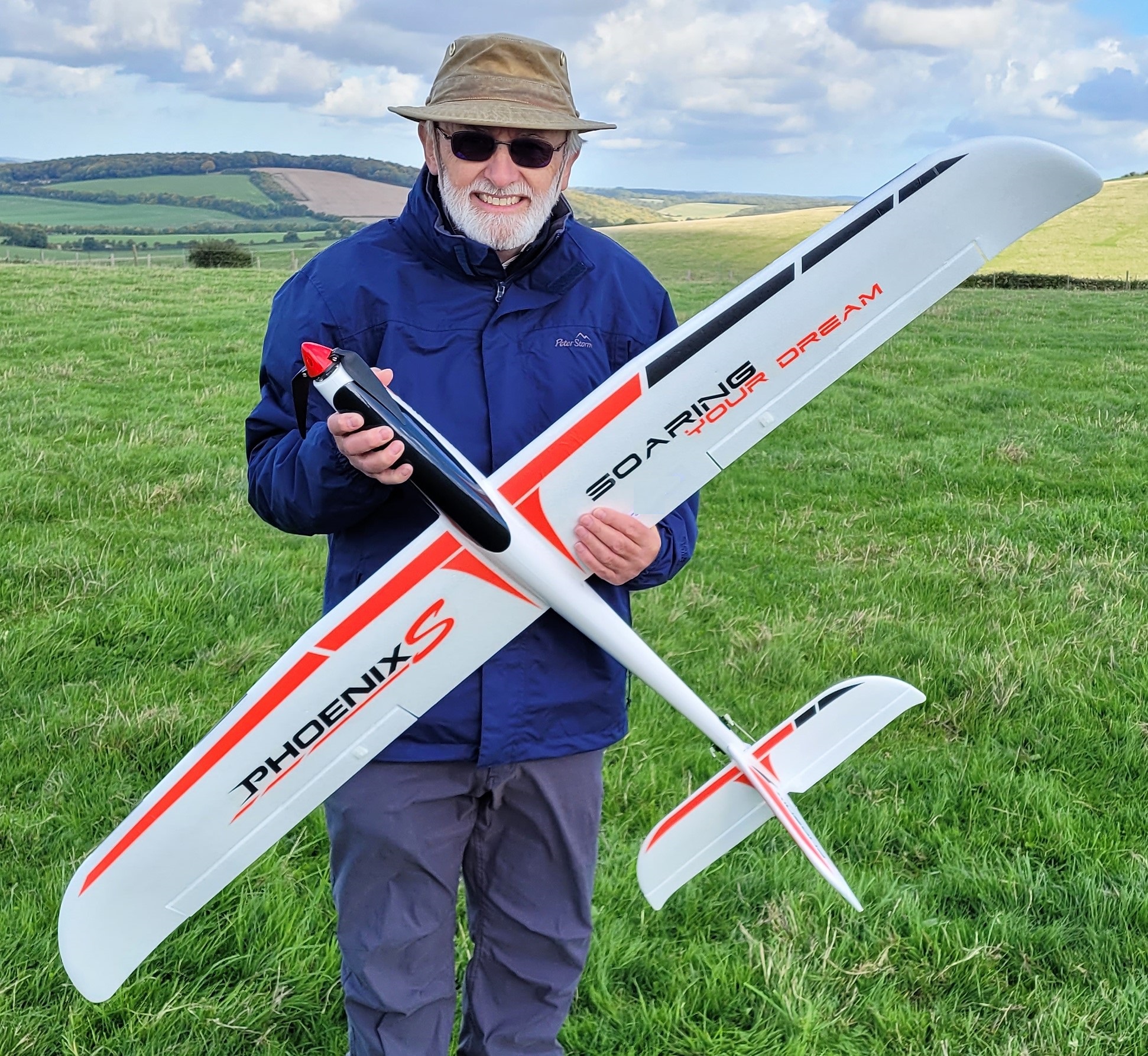
I spotted this little grasshopper trying to hitch a ride on my Yak-130 one nice August day: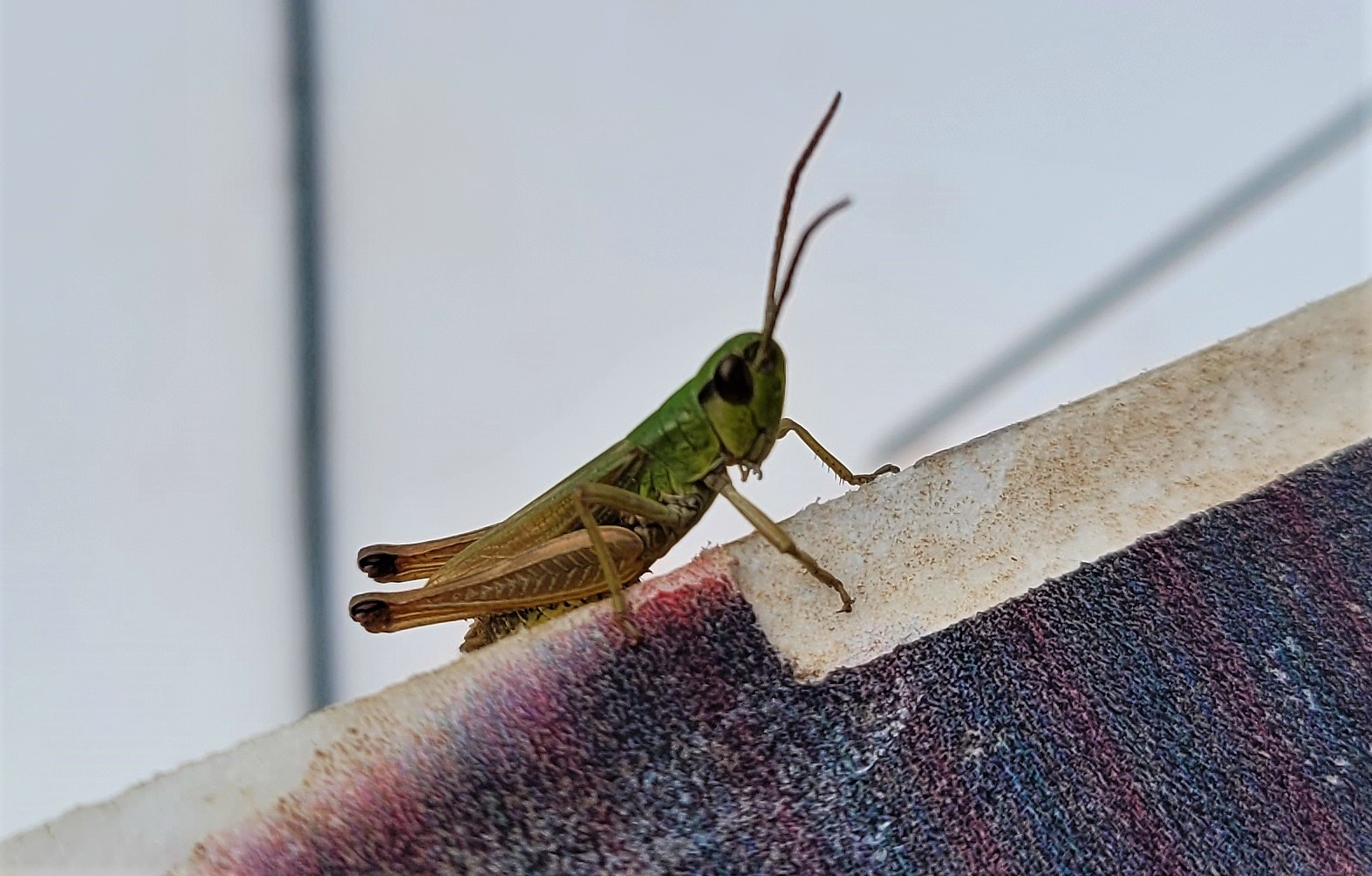
On the subject of my Yak-130, that nasty Bennett bloke attacked it with his Mig-29 but came off worse and we later found part of Gordon’s leading edge on the edge of the patch. 
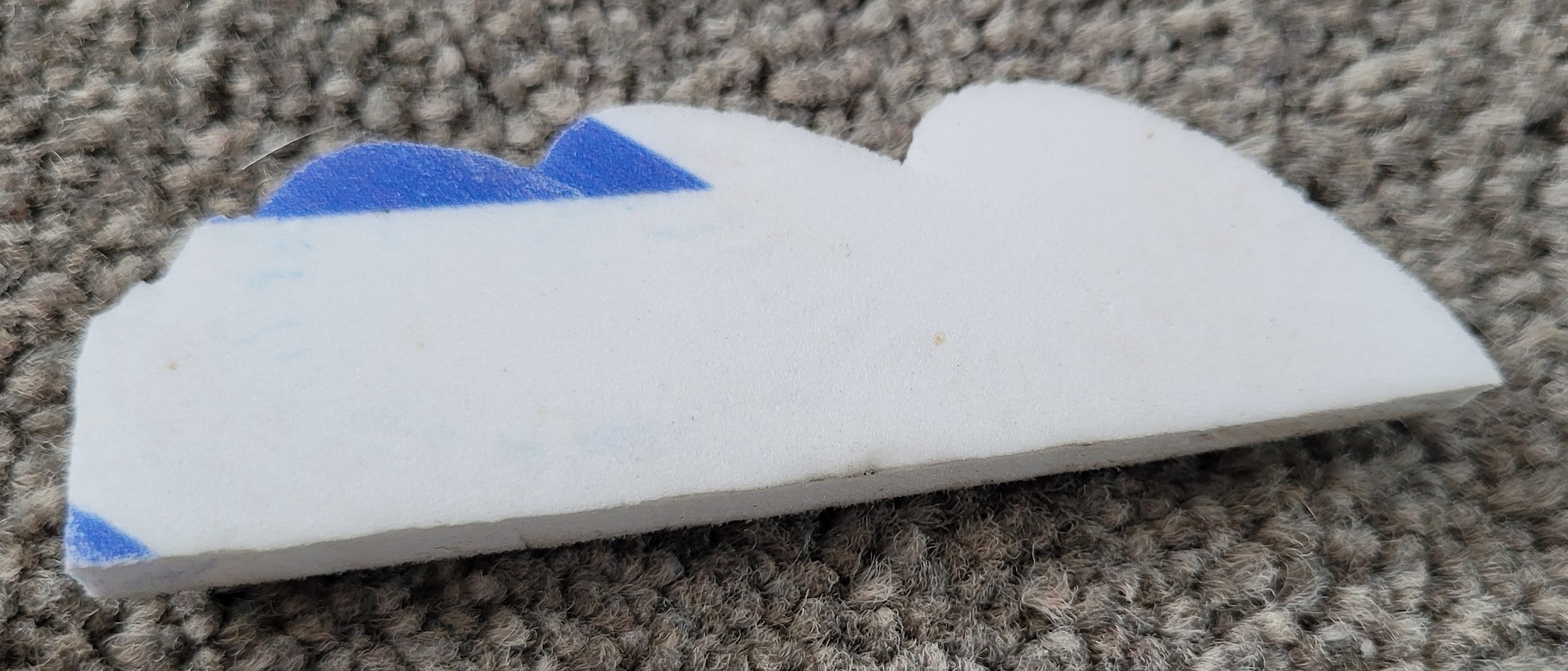 Later in the month Woody’s Raptor decided to have a go at my Yak and chewed a bit off the fuselage without getting any damage to his Raptor. I’ll remember that one Woody!
Later in the month Woody’s Raptor decided to have a go at my Yak and chewed a bit off the fuselage without getting any damage to his Raptor. I’ll remember that one Woody!
Bob the Builder has been at it again, building I mean. He calls his new model Bob’s Twin Bitsa, so called because 95% of it is from bits he already had in his workshop. The Bitsa uses the 1200mm span wings from his late lamented Sonic Modell Binary twin (the same model that Dougal uses for FPV) complete with the two 1100kv motors spinning contra-rotating 8×6 propellers. The wings are fitted with ailerons and also two position flaps.
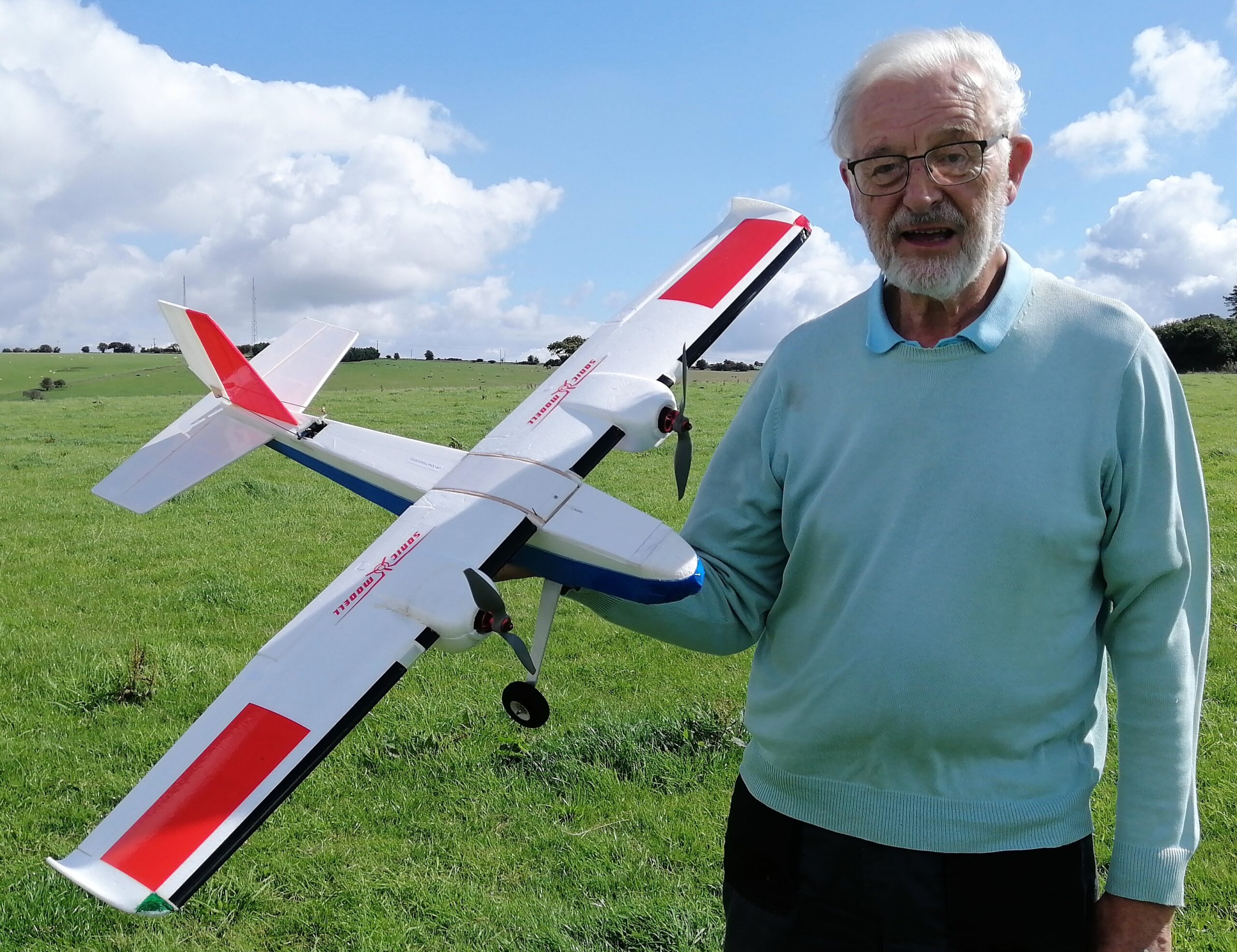 The fuselage is Bob’s own design and is made from foamboard and plywood and he’s covered it with packing tape. It houses two 30A speed controllers, one for each motor, which he has arranged to give differential thrust via the rudder stick. The tailplane is made of balsa and the fin is foam, they look very much like Splot parts to me so maybe they are also salvaged parts. The receiver is an FR Sky S8R that has a built-in gyro and Bob can adjust the gyro gain from his transmitter. The Bitsa can fly on either 3 or 4 cell 2200mAh lipo packs and on 3 cells the motors produce 400W and that rises to 700W on 4 cells. With an all up weight of just 38oz and a wing loading of 17oz per sq. ft. that’s plenty of power.
The fuselage is Bob’s own design and is made from foamboard and plywood and he’s covered it with packing tape. It houses two 30A speed controllers, one for each motor, which he has arranged to give differential thrust via the rudder stick. The tailplane is made of balsa and the fin is foam, they look very much like Splot parts to me so maybe they are also salvaged parts. The receiver is an FR Sky S8R that has a built-in gyro and Bob can adjust the gyro gain from his transmitter. The Bitsa can fly on either 3 or 4 cell 2200mAh lipo packs and on 3 cells the motors produce 400W and that rises to 700W on 4 cells. With an all up weight of just 38oz and a wing loading of 17oz per sq. ft. that’s plenty of power.
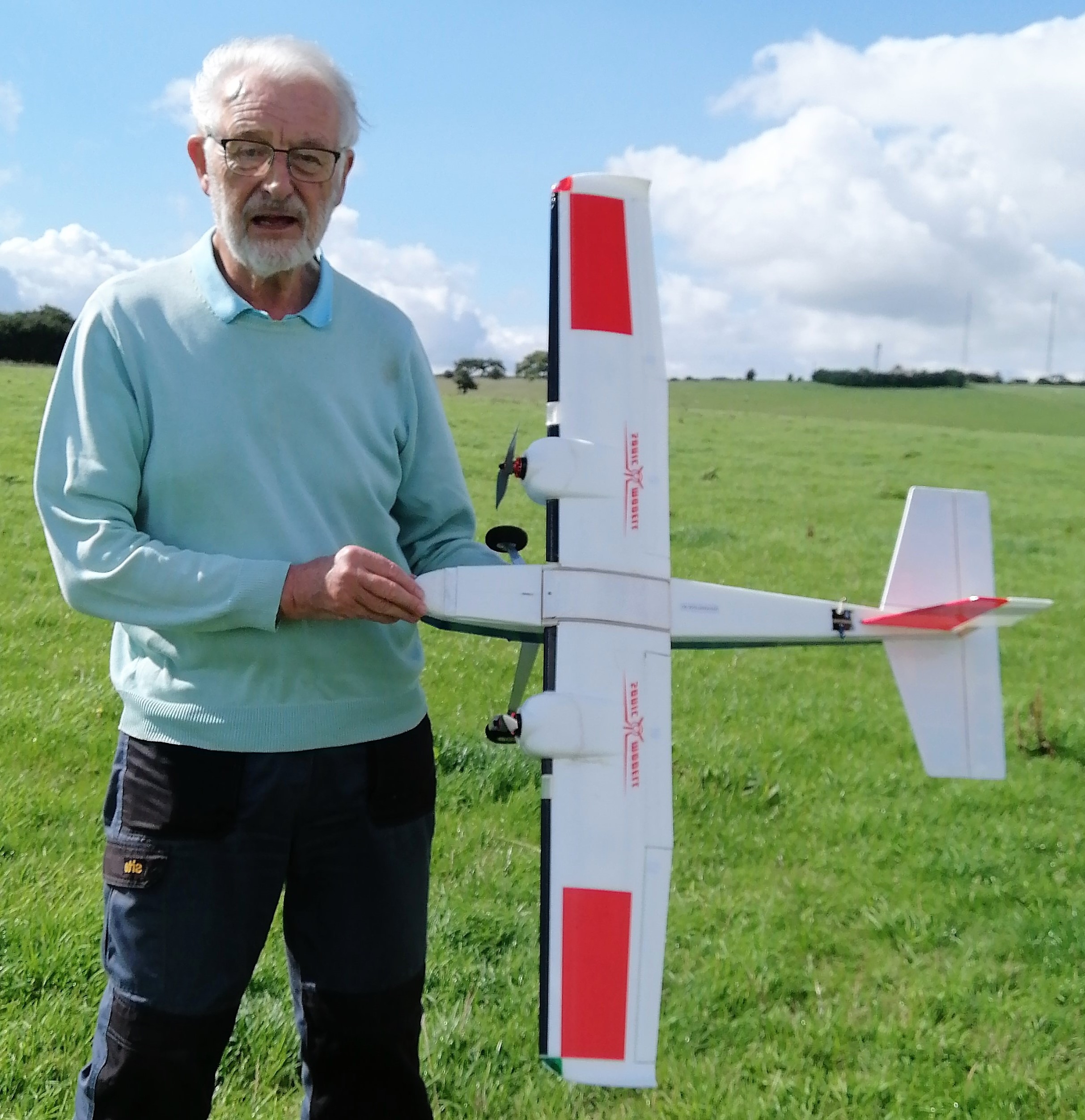 Dougal did the test flight and trimmed the Bitsa on a day with strong winds and reports that it will climb vertically on 3 cells and after five minute flights it still landed with 75% left in the battery. Bob is very pleased with the Bitsa and is now experimenting with the settings on the gyro, differential thrust, and flaps. Well done Bob, please don’t break it! The Bitsa can be seen being test flown on it’s first flight by Dougal in this months’ video.
Dougal did the test flight and trimmed the Bitsa on a day with strong winds and reports that it will climb vertically on 3 cells and after five minute flights it still landed with 75% left in the battery. Bob is very pleased with the Bitsa and is now experimenting with the settings on the gyro, differential thrust, and flaps. Well done Bob, please don’t break it! The Bitsa can be seen being test flown on it’s first flight by Dougal in this months’ video.
We were pleased to welcome Simon Patrick as a prospective new member in August.
Simon is already an RC flier has several models but hadn’t flown for several years.
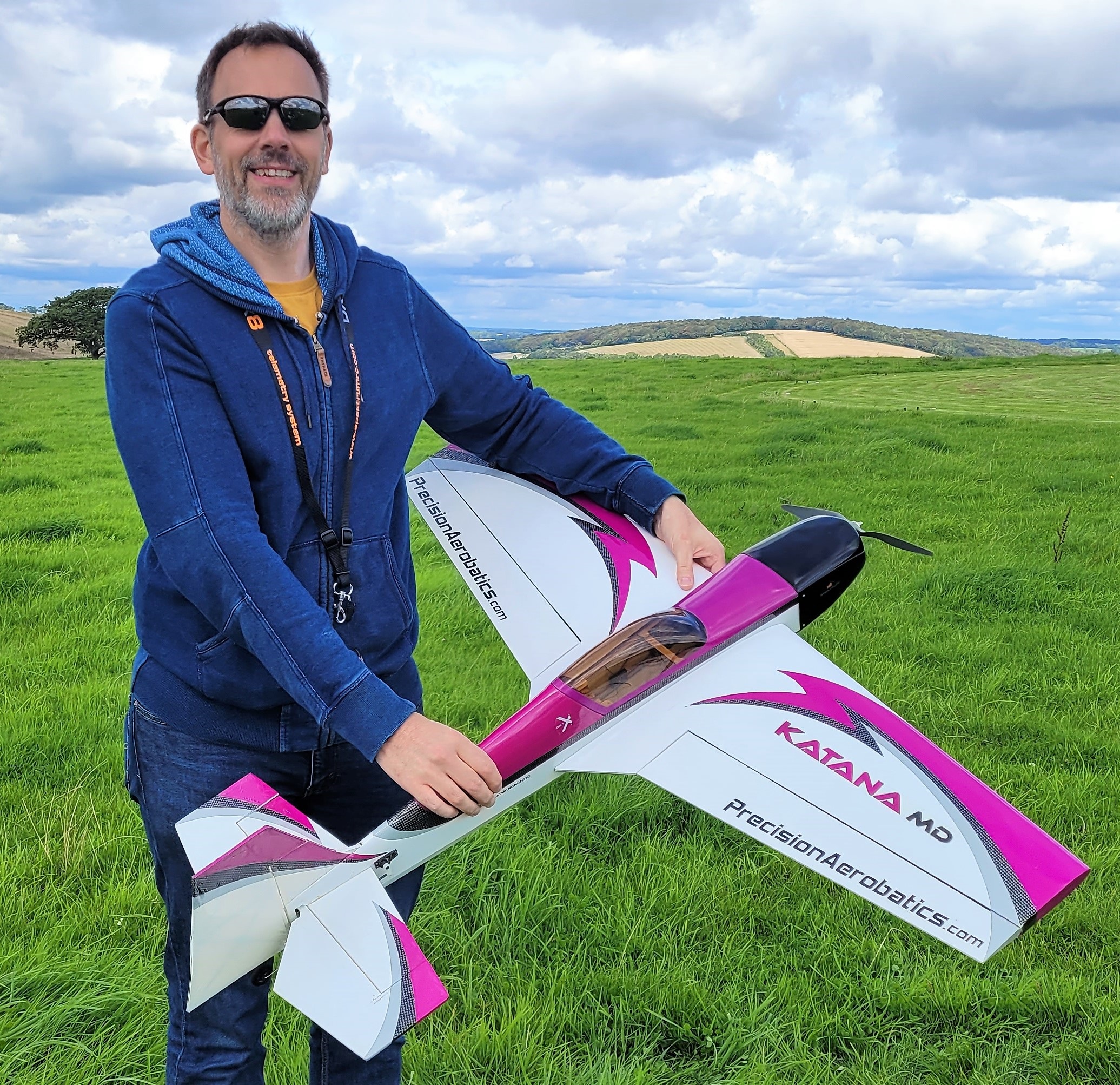 On his second visit to our patch Simon flew a Precision Aerobatic Katana MD.
On his second visit to our patch Simon flew a Precision Aerobatic Katana MD.
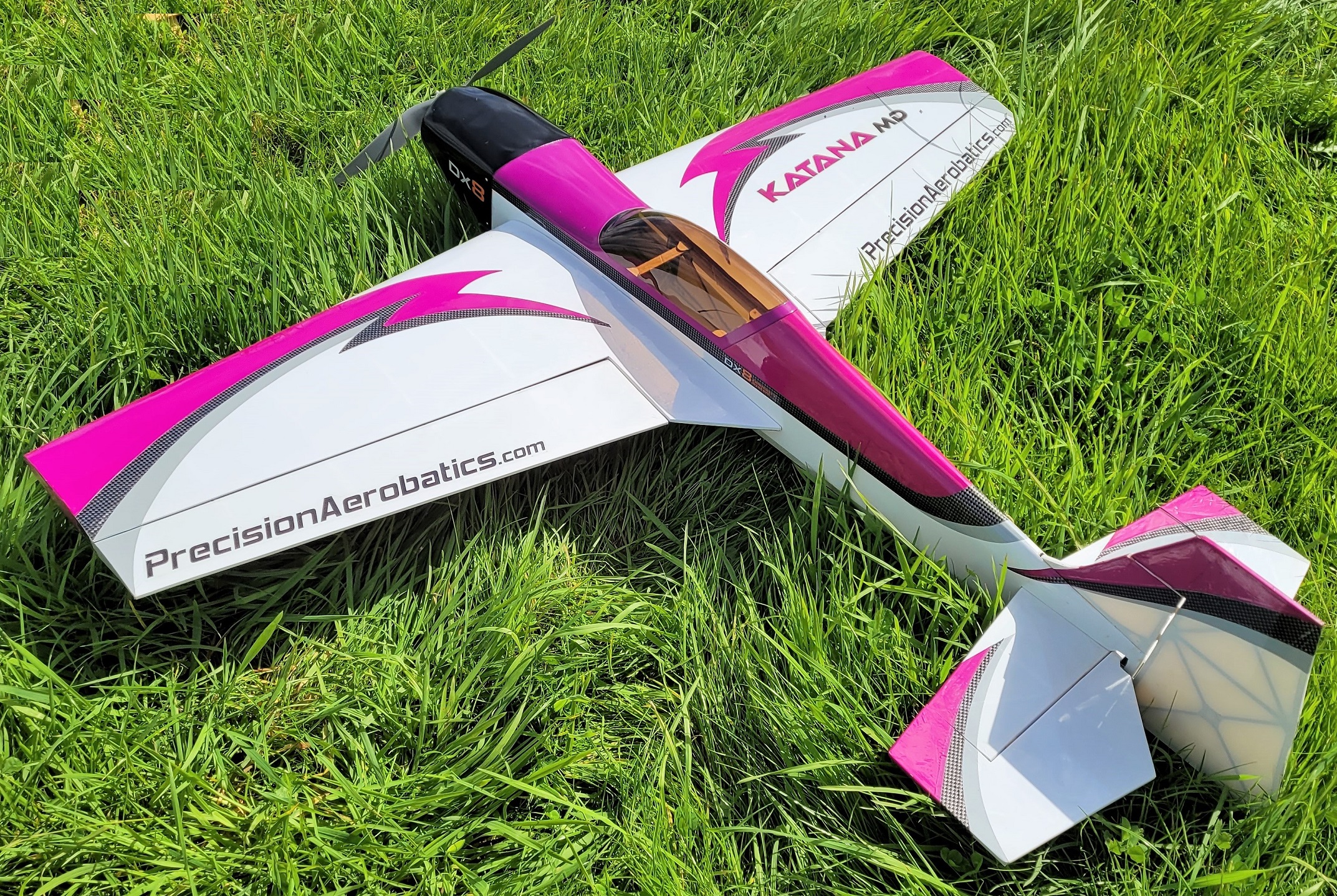 Despite having not flown for a long time Simon was fine and soon back in the swing of it.
Despite having not flown for a long time Simon was fine and soon back in the swing of it.
Kryten made it to the field several times in August and as well as enjoying flying his E-Flite Apprentice and Max-Thrust Riot he managed to snap some excellent action shots for us:
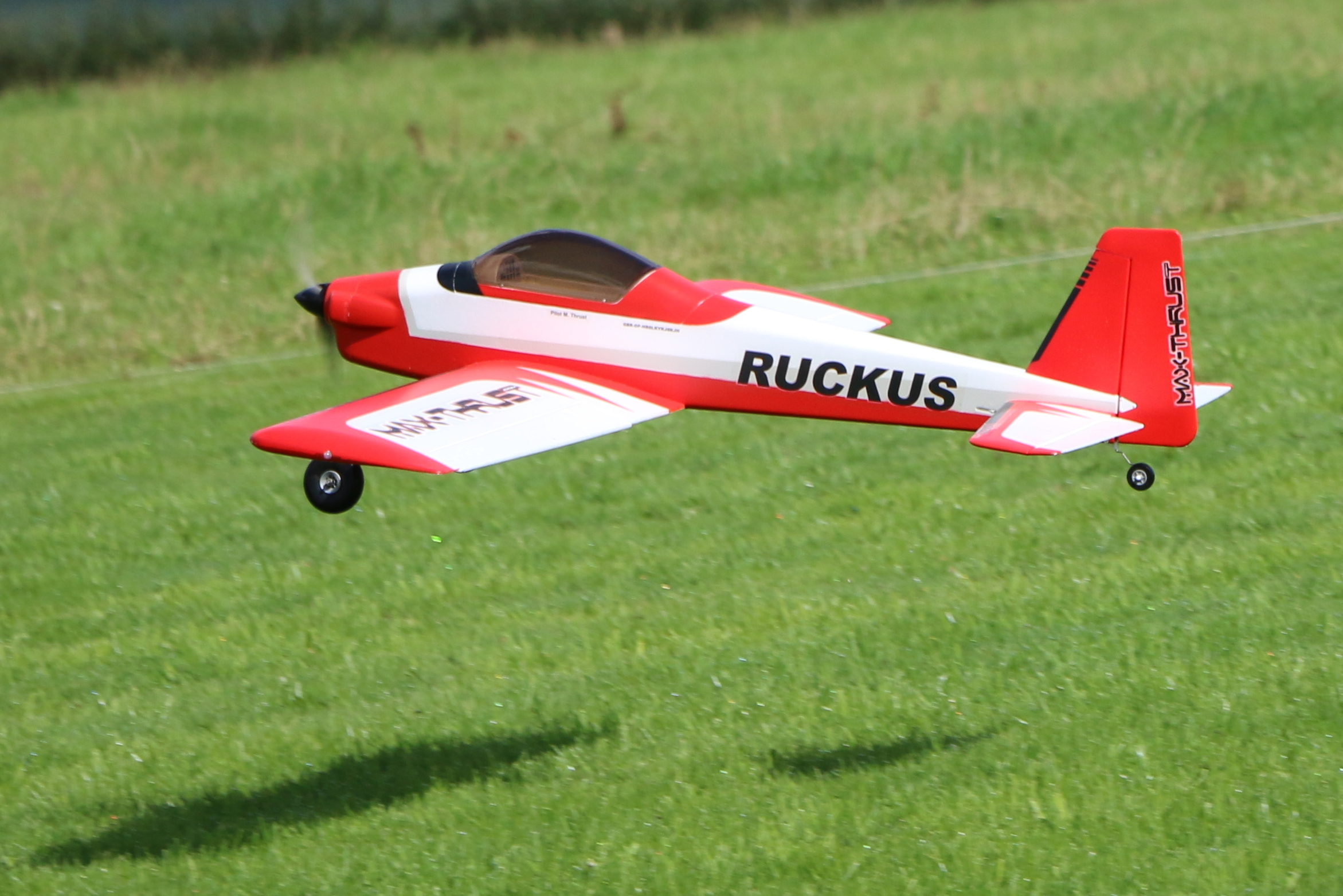
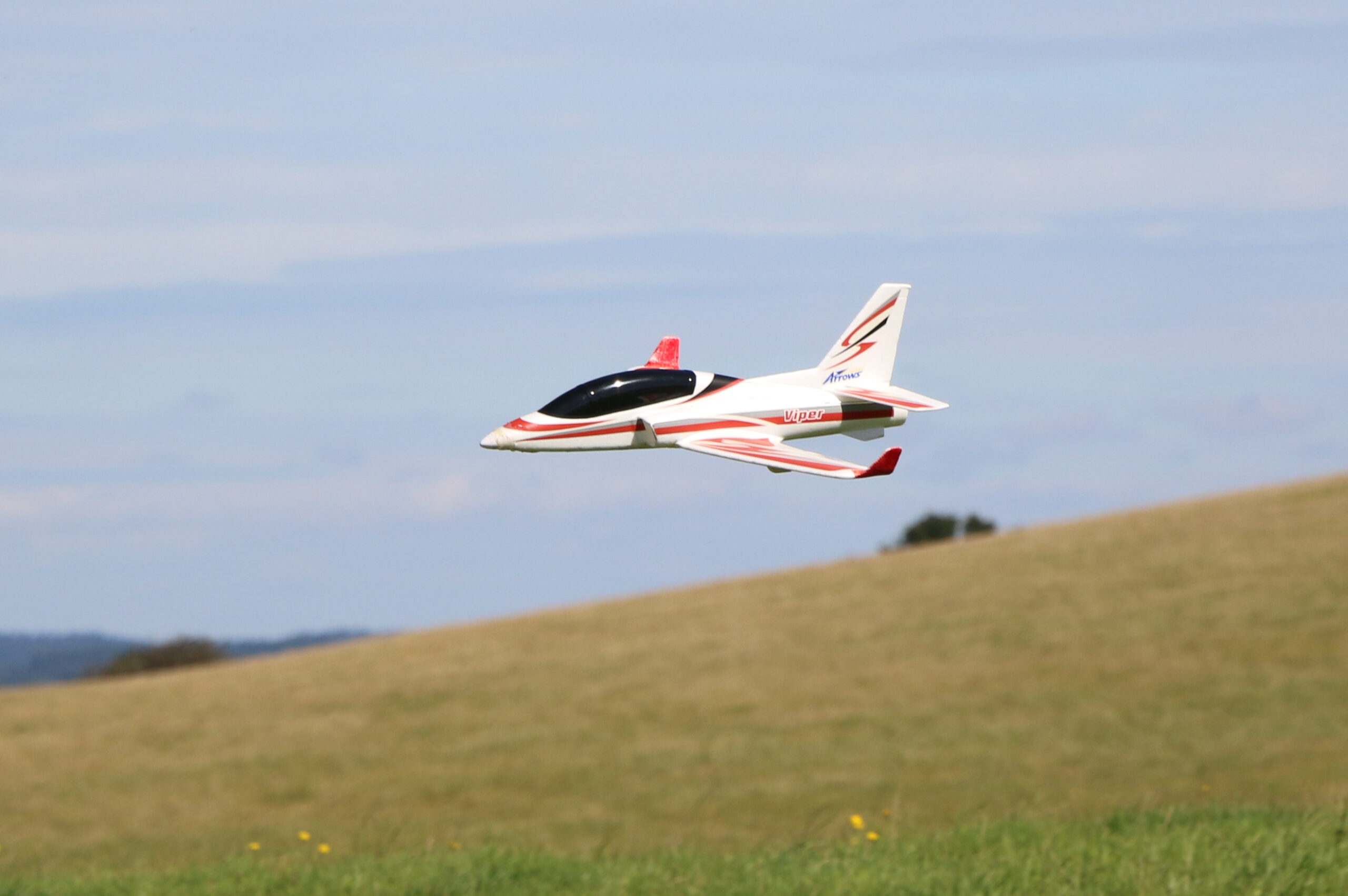
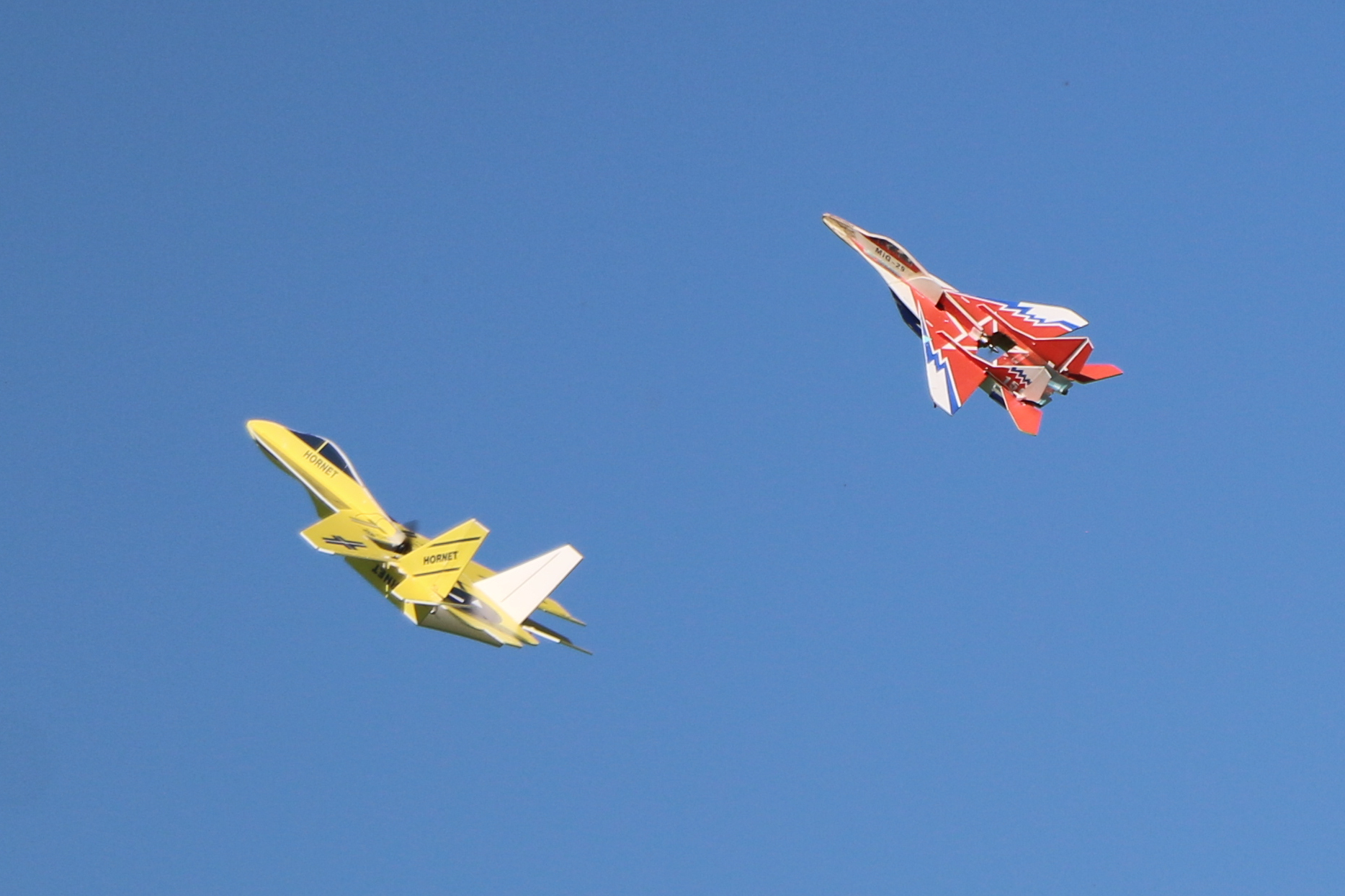

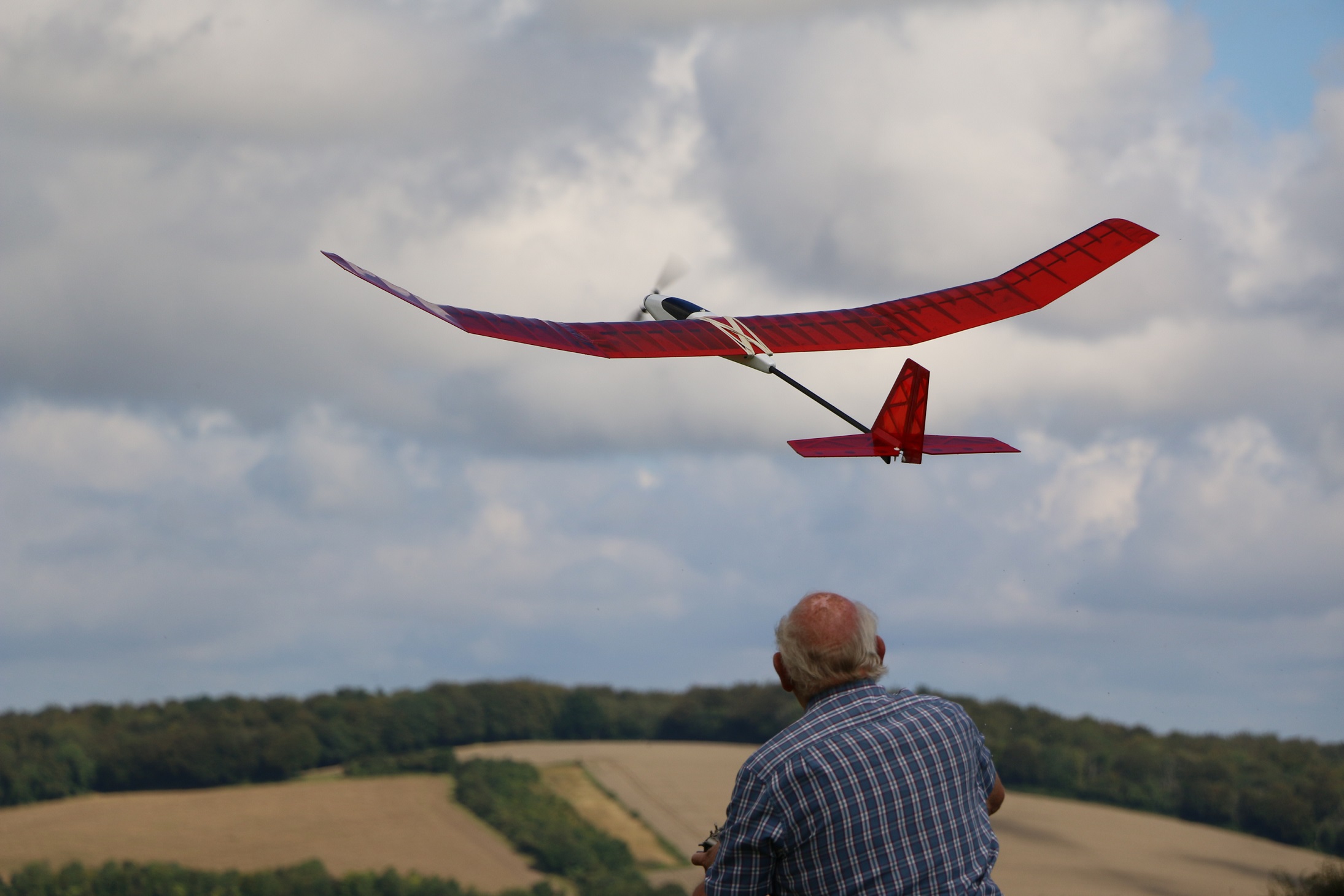
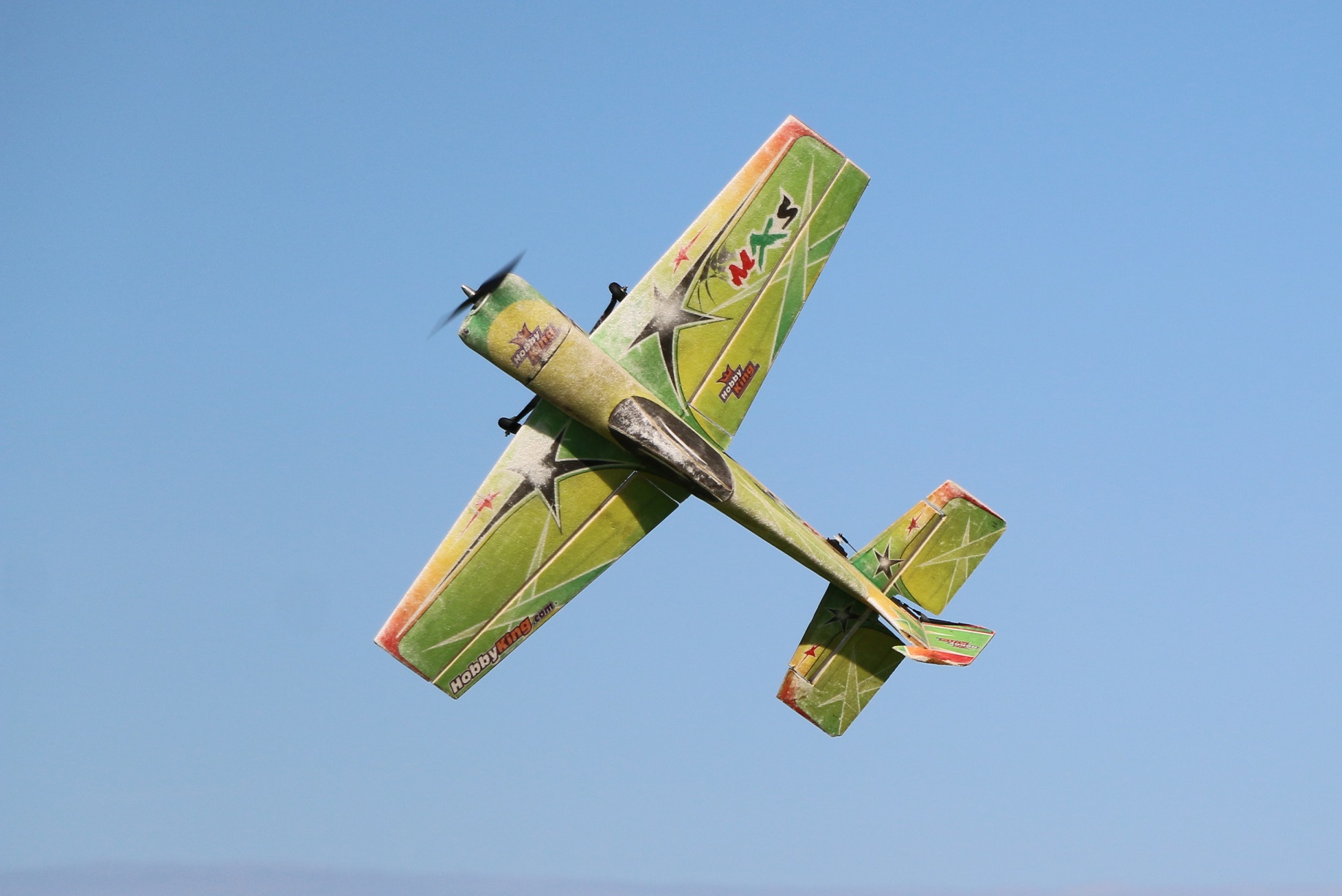
It’s video time now, this month with some footage shot by myself and Dougal Entendre but mostly by MacFly. He must have a very steady hand as he takes great video with his phone. Please watch the video full-screen, it’s so much better with small models flying around:If the video won’t play for you please click HERE
This is supposedly a true story:
On a flight from Alaska to Tokyo, the flight engineer went back into the passenger cabin.
An elderly woman passenger stopped him and asked him what the temperature was.
‘It’s 70 degrees, madam,’ he replied, adding, ‘But outside it’s 30 degrees below zero.’
‘Young man,’ the woman demanded, ‘What were you doing outside?’
Colin Cowplain


Nice one Colin!
Thanks Gordon 🙂
Great job Colin, enjoyed that !
Thanks Pageboy 🙂
A great patch news well done.
That’s because you wrote a chunk of it Dwayne!
It will do
The emojis attatched to my comments did not show LOL.
I’ll imagine them 1066
Well that’s weird, nor did mine! I was laughing